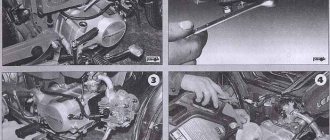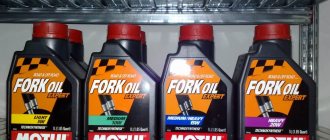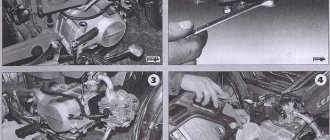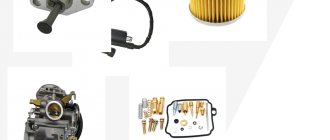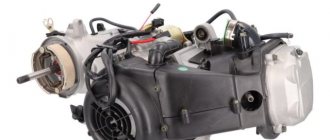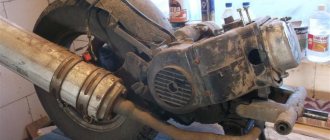It would seem, what could be simpler? I drained the old oil and filled in new oil, but no... There are people who manage to mess up here too.
I won’t go far for examples: I had the opportunity to repair several scooters whose oil filter was simply clogged with debris. As a result, the oil could not flow through it to the rubbing parts and the engine seized. To my fair question to the owner: why didn’t you clean the filter when you changed the oil??? A typical answer followed, which frankly killed me: “why clean it?” “What filter is there?” (???).
I sometimes get the impression that many scooter owners compete with each other to see who can destroy their vehicle the fastest. And then they complain on every corner that the “Chinese” are shit a priori.
So, the most common mistake made when changing engine oil is when, out of ignorance or on purpose, the oil filter is not cleaned.
Look, the owner of this scooter never cleaned the filter, and he changed the oil regularly: every 2000 km. As a result, the filter became clogged and the engine seized.
The second most common mistake I have encountered is when the oil is drained not through the drain plug, but through the filter plug. By and large, this is not critical, but if you drain the oil through the plug, the oil does not completely drain from the engine, and when you fill it with fresh oil, it will mix with the old one, which will greatly worsen its performance.
When changing the oil in the gearbox, the situation is no better. Many owners do not even suspect that the scooter has a gearbox and the oil in it needs to be changed as often as in the engine. That is, every 2000 km.
Sometimes you open the gearbox of some old scooter, and instead of oil there is some kind of slurry there. What can I say - it’s slurry. They poured oil there at the factory, but no one has changed it yet.
I recently disassembled the gearbox of an old Honda and instead of oil there was a slurry that looked very much like dung... The bearings were naturally “taken away”, it’s good that I looked there in time, otherwise the rear wheel along with the axle in front of the scooter would have rolled, and the owner would have rolled into a ditch...
Look at the fluid in this gearbox... I wouldn’t be surprised if it’s still the original factory oil...
Actually, the oil change itself, both in the engine and in the gearbox, consists of two main stages: preparatory and, strictly speaking, the replacement itself.
Preparation
To ensure that all the used oil leaves the engine without any residue, the engine should be thoroughly warmed up before changing the oil. Or, what would be best, start changing the oil immediately after a 5-10 km trip.
The second preparatory stage is that we need to prepare in advance a flat area on which to install the scooter in the most level position possible and prepare a suitable container for used oil.
The tools you use also play an important role. Don't skimp - buy a new head with a knob. You will only need two of them: for 17 and 10. Those who neglect this point pay dearly later, and out of their own pocket.
What kind of oil to fill in a Honda Dio 27 moped
Any scooter owner is interested in his car serving him trouble-free for as long as possible. It is known that scooters can be equipped with both two-stroke and four-stroke engines.
We recommend: What kind of oil to pour into the Honda Gx 160 engine
Unlike two-stroke walk-behind tractors, modern scooters with a 2T engine do not need to manually mix gasoline and oil. Two-stroke machines have a separate lubrication system, disc brakes, and an electric starter.
But, despite the fact that technology has come a long way even over the last ten years, this does not mean that it does not require constant care. Scooter maintenance involves, among other things, timely replacement of consumables. And the first rule is to use oils and additives intended only for scooters, and not for other equipment.
Changing engine oil
Draining used oil
We place the scooter on the center stand; if it is crooked, we straighten it. On the left side in the direction of travel of the scooter, at the very bottom of the engine, look for the drain plug, place a previously prepared container under the plug and unscrew the drain plug with a 17mm head.
While the oil is draining, go to the right side of the scooter and unscrew the dipstick and the oil filter plug, which is located at the very bottom of the engine.
We put a good 17 socket on the plug, unscrew it and remove it with all its contents from the engine.
This is the oil filter. Immediately after unscrewing it, while the point is still important - throw all this junk into clean gasoline, give it a good shake, and then blow it out and dry it.
After the oil filter plug is removed from the engine. In order to remove any remaining oil from the engine, pump the engine several times using the kickstarter.
Then we wait about five minutes - wipe the drain holes dry, for greater reliability, apply sealant to the plugs and screw them into place.
Filling the engine with new oil and checking its level
Depending on the design of the canister, pour oil into the neck either directly from the canister itself or through a funnel. The funnel must be clean!
Oil level control
The oil level is checked as follows: pour the first portion of oil into the engine, approximately 600-700 ml, wait a couple of minutes until the oil spreads evenly over the crankcase without twisting, insert the dipstick all the way into the filler neck, remove it and check the level.
The oil level must be within the control area.
- If the level is lower, add a little oil, wait a couple of minutes and take a measurement.
- If the oil level is higher than normal, drain it or, better yet, pump it out using a syringe with a tube from the neck.
The control area is indicated by red arrows. In my case, the oil level is exactly in the middle of the control section and is indicated by a blue arrow. Ideally, the oil level should be near the upper boundary of the control section. But this is ideal, but in practice, the average level is quite acceptable and does not in any way affect the reliability and durability of the engine.
Honda Dio won't start - DIY car repair
Dio 35 combi brake system Fuel level is normal.
Moreover, there is a completely plastic float, the level cannot be adjusted. The needle does not jam. The speed rises and falls after heating. The only thing today was that I slightly adjusted the height of the solenoid valve and unscrewed it one turn.
It seemed to me that he did not open the channel enough. I'll try again tomorrow morning and report back. Added The case turned out to be in the enrichment plant.
It works, but it needed to be adjusted in height. Which is what I did yesterday. This morning the moped started right up with half a turn. Thanks to everyone who responded. Added It's again.
Actually, this morning everything happened again. But now it has gotten even worse. Basically started up.
Why does the Honda Dio Af 35 scooter start poorly when cold?
But it warmed up and stalled. After this, it starts with difficulty and immediately stalls. You add gas as soon as you start it and it stalls.
You plug the hole in the air filter - it works, remove your hand - it stalls.
The level in the carb is normal, the needle is in the middle position, the carb is clean, the Honda Dio solenoid valve does not start well when cold, the fuel pump is pumping, there is compression, I don’t know how much spark there is, there is no air leak, I’ve screwed everything up.
Check the air filter for contamination, clean it or replace it with a new one. Make sure the exhaust system is clean. It is also advisable to rinse in gasoline and blow out all channels and jets in the carburetor with compressed air.
Only after this you can start making adjustments. Carburetor adjustment The needle in the air damper can move relative to it within small limits.
I think the experts will tell you something. Also, sometimes I take my daughter with me to the store, she weighs somewhere. I think there is compression, otherwise I wouldn’t fly up the hill.
Changing the oil in the gearbox
At the very bottom of the engine, on the left side in the direction of travel, we are looking for the drain and filler plug of the gearbox. The filler plug is located on the side or on top, and the drain plug is always at the bottom.
Place a container under the drain plug and unscrew both plugs.
We wait about ten minutes until the old oil drains from the gearbox.
We wipe the drain hole and plug dry, apply sealant to the plug and screw it into place.
Let's take the oil. I take a liter canister, it’s cheaper and lasts for about 10 replacements. If you change oil infrequently, buy a special tube of branded oil for scooter gearboxes. There is more than enough of it for one replacement, and without unnecessary headaches, pump it into the filler hole using a special spout.
Like this
For those who prefer to save money, there is only one thing left to do: pump oil into the gearbox in small portions using a regular syringe. Unfortunately, there is no other way to fill the gearbox with oil because the filler hole is too small.
Checking the oil level in the gearbox
We pump oil into the filler hole, also known as the control hole, until it begins to flow out of it. As soon as the oil starts to flow, stop pouring, wait a couple of minutes for the excess to drain, and tighten the plug.
On some models of scooters, there is no control hole through which we can determine the required oil level and instead there is a filler located on top of the gearbox and a drain. In this case, the recommended oil level should be marked on the engine crankcase. This simplifies the work: measure out the required amount of oil and pour it through the filler hole into the gearbox.
Scooters Maintenance and repair
Often, when it is recommended to manually add oil to gasoline in a certain proportion when operating a two-stroke scooter, scooter owners cannot always quickly determine the required amount of oil, which can be poured directly into the tank or mixed in a canister.
This material will help you quickly understand the proportions and add the required amount of oil to a certain amount of gasoline in a matter of seconds without additional calculations.
When to add oil to gasoline
- The most important thing is that the scooter must be two-stroke. Mixing oil with gasoline for four-stroke engines is unacceptable!
- During the run-in period in very hot weather, to prevent the piston from jamming in the cylinder.
- If the oil pump malfunctions, when it cannot be adjusted, and operation of the scooter is urgently necessary.
- In the absence of an oil pump. Yes, this happens, especially when tuning. Scooter riders prefer to prepare a mixture of gasoline and oil on their own and pour the prepared mixture into the gas tank; in this case, of course, the oil pump is no longer needed and there is a plug instead.
- If the performance of the oil pump is insufficient after increasing the piston volume.
- Other cases.
How to choose NGK spark plugs. Selection by marking
How much oil should be added to gasoline
For example, a master can indicate the proportions after repair or tuning, when he knows the performance of the pump of a particular scooter and sets a certain proportion to replenish the missing amount of oil.
When running a two-stroke scooter, it is enough to add oil to gasoline at the rate of 1 to 30 with a fully functioning oil pump. You can find out more about this in the article:
- Running in a piston two-stroke scooter.
Now, actually, the table itself. Very simple and intuitive. The leftmost column is the number of liters of gasoline to which we will add oil.
In the header of the table we see the ratio that we need (1 to 20, 1 to 30, etc.). And in the body of the table we see the required amount of oil.
For example, during break-in, you need to add the required amount of oil at the rate of 1 to 30 to the five-liter gas tank of a Honda Dio scooter.
In the left column we select the number 5, in the top line we select the ratio 1/30, in the intersection we see the number 167. This is the amount of oil that we need, i.e. 167 ml.
Source: https://scooter-remont.com/?p=6398
Increased fuel consumption on a scooter, reasons
According to trends in world gasoline prices, we don’t have to wait for prices to drop, but on the contrary, we see a constant increase in the amount every time we refuel a scooter. From here you can’t help but wonder if the scooter consumes a lot of gasoline? And in most cases we notice that he “eats” more than four liters per hundred, and sometimes five or more.
The main reasons for increased fuel consumption.
- You should check the fuel line for leaks, the hose may be cracked, the clamps attached to the carburetor or the fuel pump may have become loose.
- Check the tightness of the carburetor float chamber cover.
- Check the air filter; if the filter is clogged, the mixture becomes rich, which leads to excessive fuel consumption.
- A loose main fuel jet can cause excessive fuel consumption.
- Excessive carbon deposits in the muffler and engine.
- All kinds of ignition faults, from a bad spark plug to late ignition.
- Tires that are under-inflated contribute to increased load on the engine, which in turn can also cause increased fuel consumption on the scooter.
- Piston wear.
- Driving style, when the throttle is almost always turned to full, is the main reason for excessive fuel consumption compared to the standards stated by the manufacturer. Try not going faster than 40 km per hour for a while and you will be pleasantly surprised by the reduction in fuel consumption of your scooter.
You can also read other articles on the topic:
Other answers in this thread
#2 Alexsey
Actually these are the main questions:
2) Which front fork is better? They offer the same one as before, a spring Honda, Taiwan. You can also go to China, but they say it’s worse. Is it possible to install a Honda or other good hydraulic fork here?? The mechanic says that all hydraulic forks for Hondas have disc brakes (I have drum brakes). Yes, you can also put a repair kit on this fork, but as I already found out, it will last for about a season and is not the best option. Tell me what to do?
3) The scooter travels for a maximum of 50 km, but it’s the same whether it’s going up or down the mountain, that is, there is some crap in the engine, you can feel it, the traction is good. Is it worth playing with rollers to increase the speed? They say if you put the rollers at a high max. speed then the traction will be lost. And the fact that right now I have Japanese videos, factory ones, but they are sold in worse quality. How much will I receive in max. speed if I set it to max. speed rollers?? And what are they anyway, in terms of speed/traction??
#3 Alexsey
I’m starting to have a monologue on this topic. But I will say that after surfing this forum, I found answers to all my questions. Almost everything. Here's a couple more:
#4 tason
#5 Alexsey
#6 evvo
#7 Administrator
Alexsey (15.3.2009, 11:20) wrote: evvo (15.3.2009, 15:03) wrote:
both options are correct.
At the service station we use the first one. those. version with molybdenum.
But in general, if it’s wise, then manufacturers recommend changing gear oil (not topping it up) every 5000 km. and, accordingly, regular motor oil - every 1000 km

